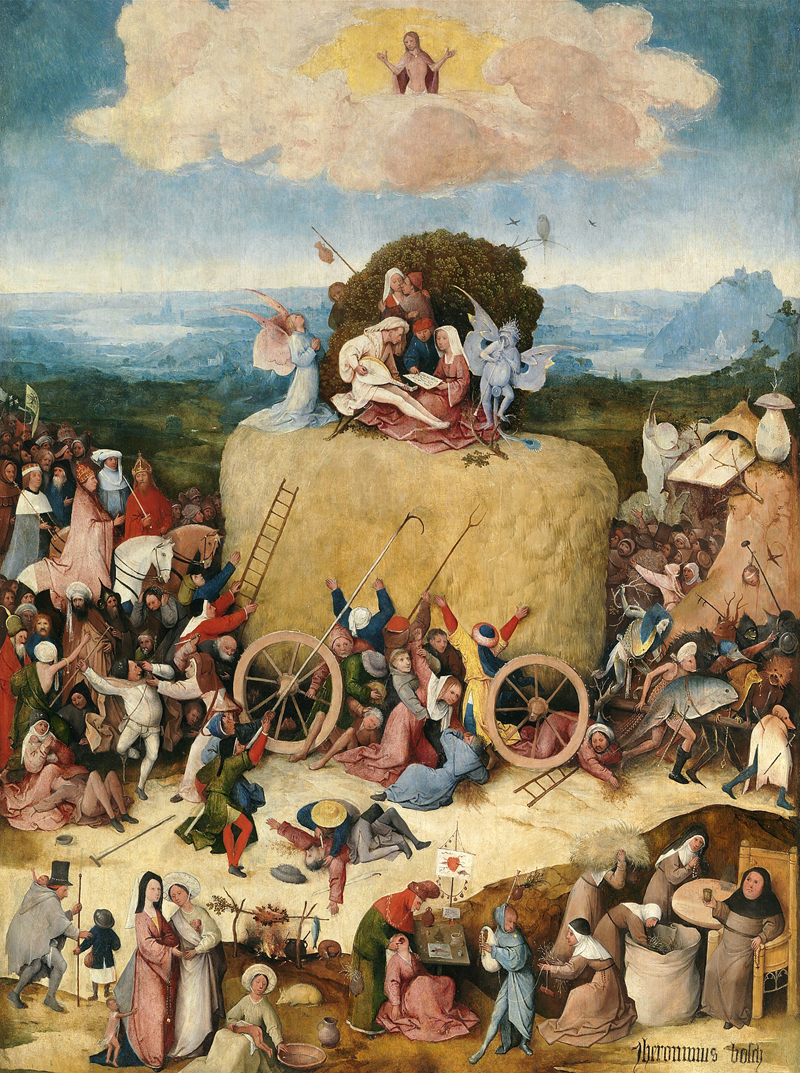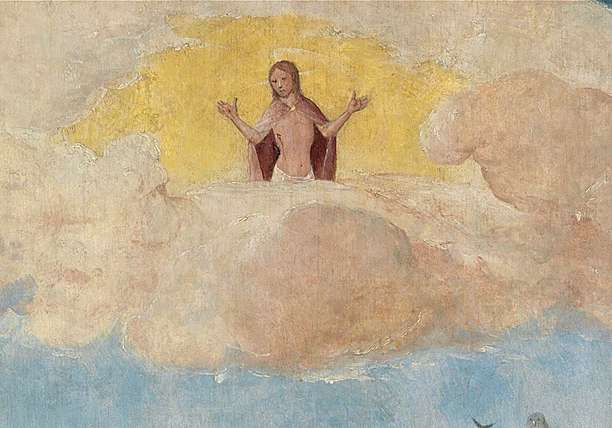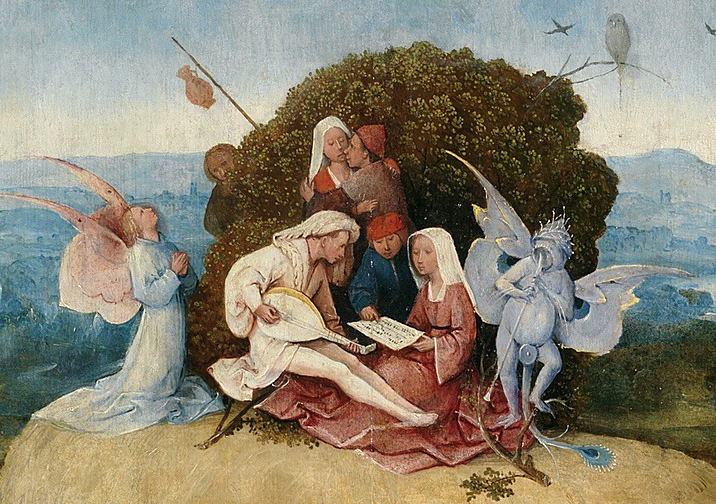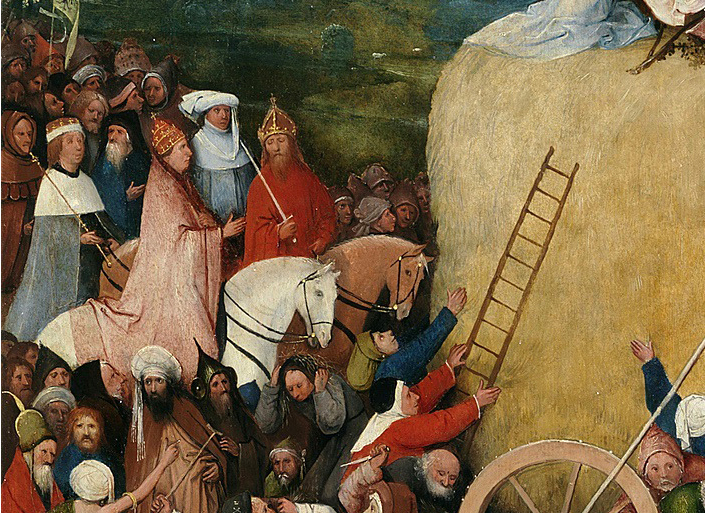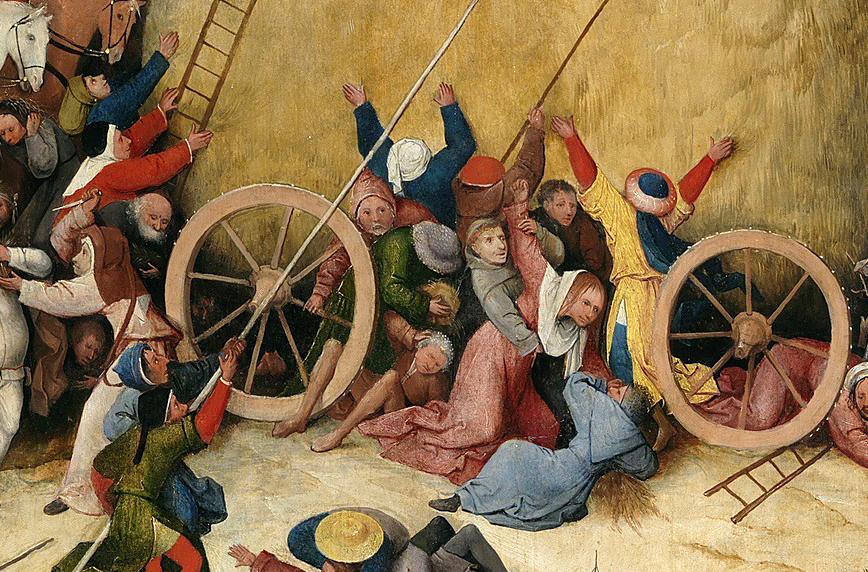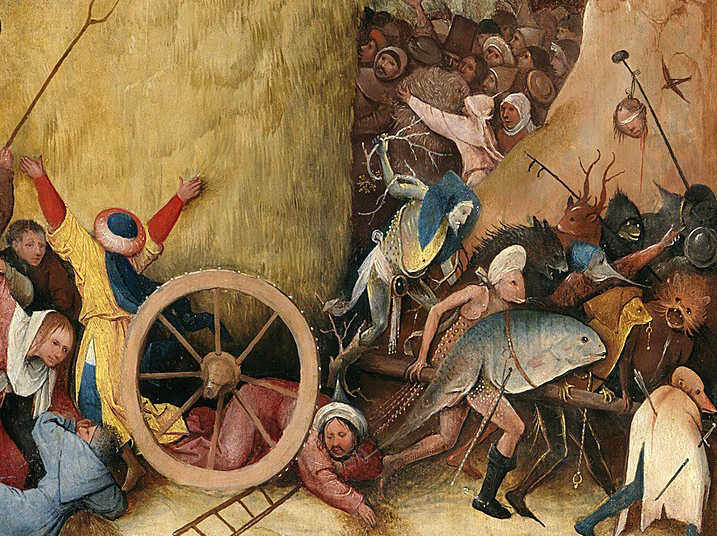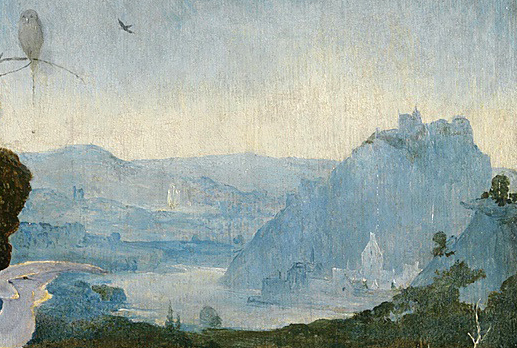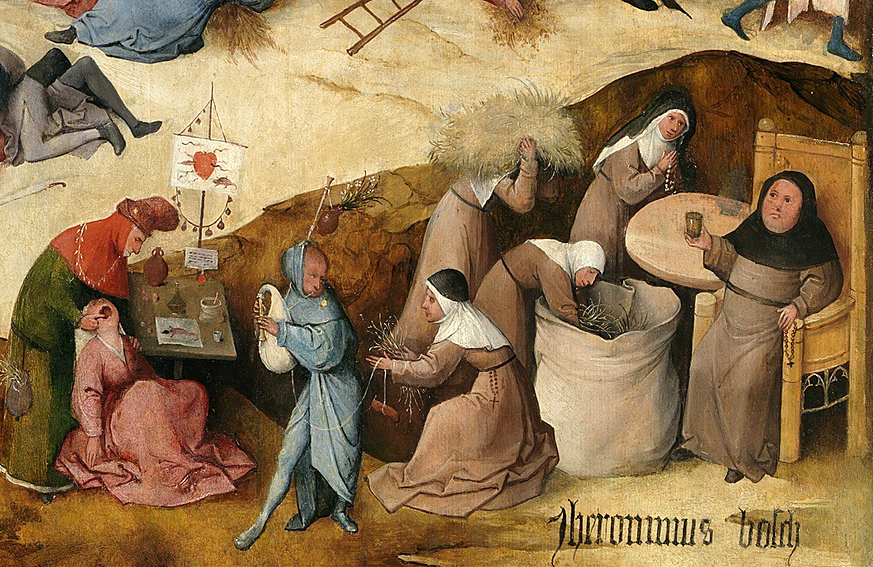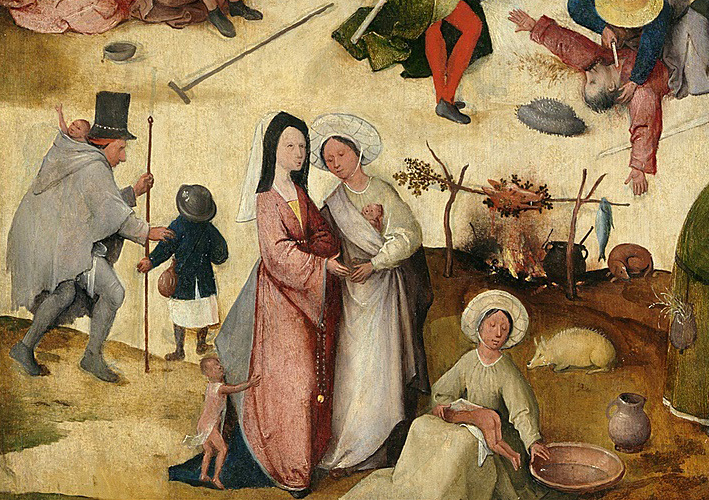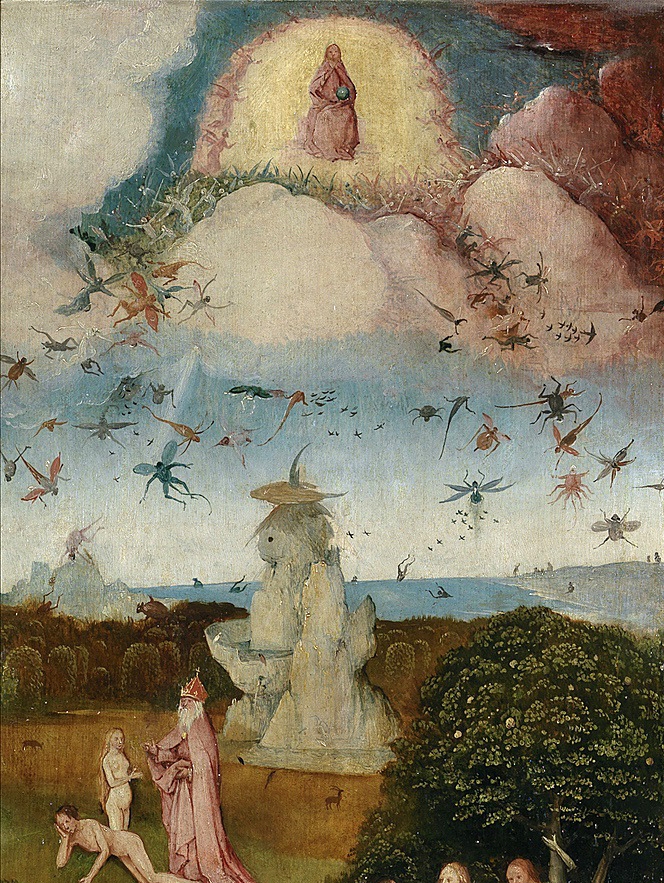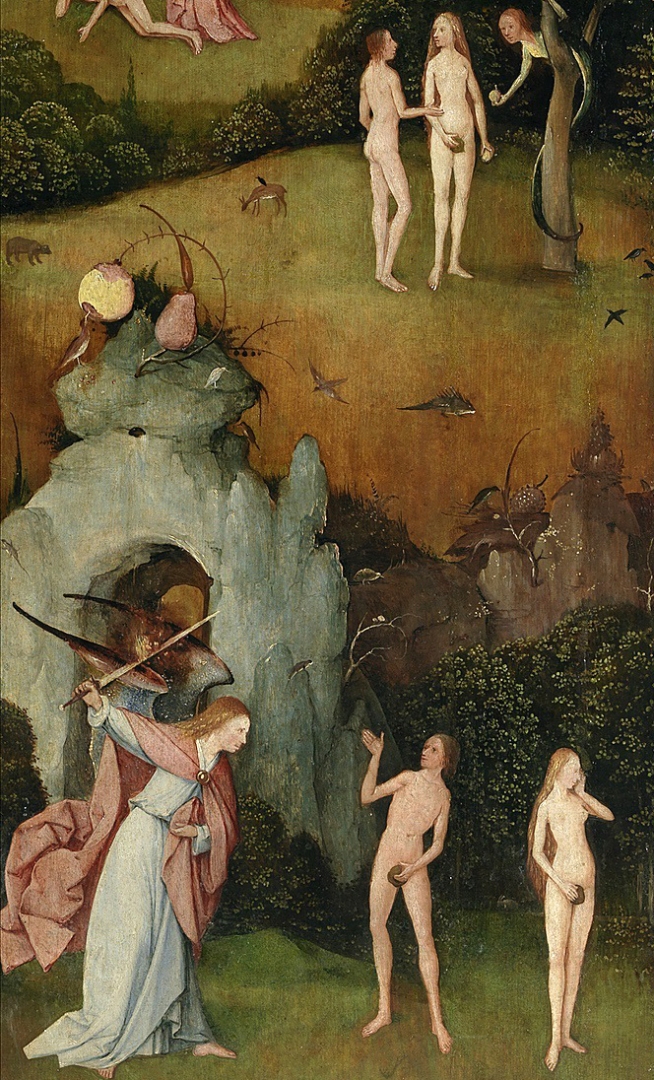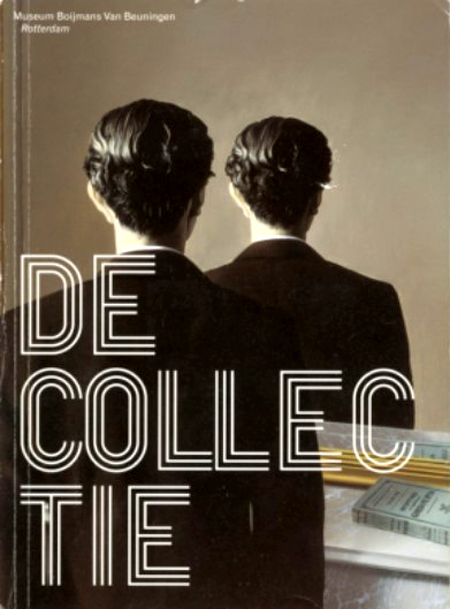Hieronymus Bosch (1450–1516)
(Boijmans van Beuningen)
Hieronymus Bosch is known for his crowded paintings, which are, as it were, a cacophony of scenes on a single canvas.
♦ Description of the Haywain
♦♦ center panel
- at the top, Christ is seen on a cloud, with his arms spread out, looking out over the people.
- In the center is the hay cart itself, with a bush on top of it, in front of which sits a man playing the lute with a couple singing along. In the bush, a couple is kissing.
- To their left is an angel praying to Christ.
- To their right is a little devil who appears to be playing the flute.
♦ Hay cart
- Behind the hay cart on the left, a procession of dignitaries including a king and a bishop or pope.
- Below and in front of the hay cart, people who have fallen while trying to climb onto it, as well as a man stabbing someone in the throat with a knife.
- On the right, the hay cart is being pulled by demonic figures, behind which a group of people are fleeing into a cave.
- In the background is a vast landscape with a river and a small castle on a mountain.
- In the foreground is a group of people who are barely paying attention to the scene, including a group of nuns and a priest on the right, a tooth puller, and a family sitting around a campfire.
♦ Iconic description
Bosch repeatedly addresses the same themes in his paintings, namely those of the seven deadly sins.
Since it would be impossible to describe everything, I will discuss the haywain, the procession in front of the haywain, and the people in the foreground. In Bosch's time, the haywain was more than just dried grass; it symbolized earthly gain.
♦♦ Text 1563:
“A cart with a satyr sitting on it, deceitfully beckoning, followed by the entire nation of people, pulling on the cart, such as usurers, cashiers, and creemers, with the iron winch already on the cart.”
In addition to this text, the group of people in the foreground of the painting provides ample evidence that hay can be seen as material property.
The tooth puller has a money bag filled with hay, and the nuns accompanying the well-fed priest are filling a sack with it. The small family is a group of gypsies, recognizable by their typical headgear, who were viewed with great suspicion around 1500.
“15th-century chronicles” report that they occupied themselves with begging, poaching, stealing, pickpocketing, palm reading, fortune telling, and even kidnapping and selling children. The foreground therefore clearly symbolizes greed.
The text from 1563 refers to usurers, merchants, and bankers, but Bosch broadens the scope by depicting secular and ecclesiastical rulers as pursuing “ertsch ghewin” (first profit). Bosch accuses them of being overly attached to profit-seeking and other earthly vanities.
The deeper meaning of the scene on top of the hay cart can be interpreted as the sin of unchastity, especially as indicated by the kissing couple. The lute player and the singing couple. ♦ Left panel: heaven ♦ Right panel: hell
The side panels depict Bosch's vision of paradise and hell, respectively.
Read from left to right, sinful man unsuspectingly turns away from paradise, toward hell and damnation, distracted by sins such as gluttony, greed, and lust.
“No one is concerned about the fatal outcome.”
Bosch's work cannot be viewed separately from the social and political unrest of the late Middle Ages and the belief that the end of the world was near. This was further reinforced by the terrible plague epidemics.
The upper social class, to which Bosch belonged, wanted to prevent the demoralized people from succumbing to a desperate attitude towards life.
Bosch was highly regarded during his lifetime.
King Philip II of Spain collected his work (now in the Prado in Madrid).
There are also many copies. Some were made in his studio in 's-Hertogenbosch, where family members, his father, brothers, cousins, and uncles, who were also painters, worked under his guidance.
Erik Beenker / Boijmans van Beuningen
The Collection
Bosch, Hieronymus_The Haywain triptych
References
Erik Beenker / Boijmans van Beuningen
The Collection
Photo's
wikipedia
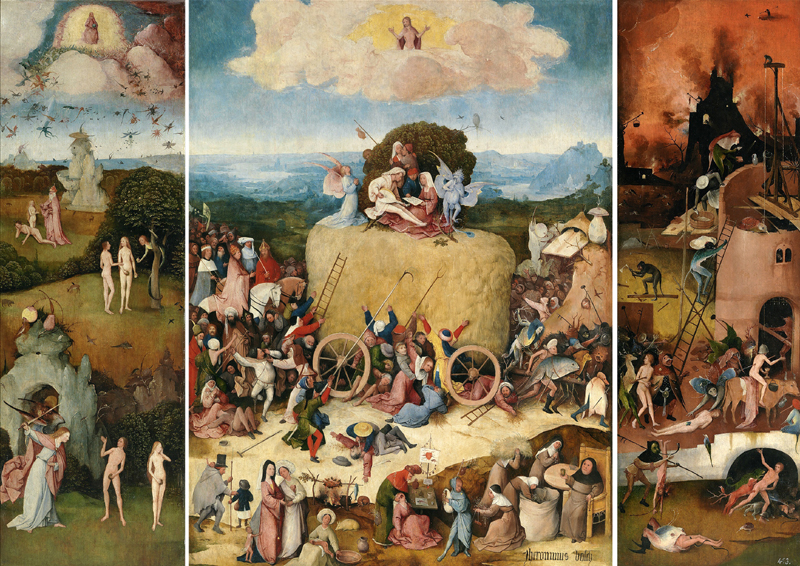
Art lijst
Schilderijen
- Bosch, Hieronymus – The Peddler
- Bosch, Hieronymus_The Haywain triptych
- Botticelli, Sandro_Primavera / Spring
- Brueghel the Elder, Pieter – The Tower of Babel
- Campin, Robert — Mérode Triptych
- Courbet, Gustave_Atelier van de schilder
- Dali, Salvadore_Verzoeking van de heilige Antonius
- Dou, Gerard_de Kwakzalver
- Eyck van Barthélemy_Stilleven met boeken
- Fra Angelico_Annunciatie
- Géricault, Théodore_Vlot van Medusa
- Magritte, Rene_Verboden af te beelden
- Matsys, Quinten_De geldwisselaar en zijn vrouw
- Memling, Hans_Twee paarden in een landschap
- Onbekend-16e eeuw_4 gedaantes van een arts
- Picasso, Pablo_Guernica
- Rembrandt_Abraham en de drie engelen
- Rembrandt_Elsje Christiaens
- Velazquez, Diego_Las Meninas
Schilderijen en de dokter
- Agenesia Sacrale (a rare congenital disorder in which the fetal development of the lower spine)
- Alopecia areata (hair loss)
- Arthrogryposis congenita (birth defect, joints contracted)
- Artritis psoriatica (inflammatory disease of the joint)
- Artritis reumatoïde
- Breast development (delayed)
- Bubonic plague
- Difterie (kroep)
- Gigantisme & Acromegalie
- Hazenlip (cheiloschisis) / gespleten gehemelte
- Herpes zoster (gordelroos)
- Hongeroedeem
- Influenza Epidemic of 1858
- Keisnijding
- Krankzinnigheid - Malle Babbe (1640)
- Kropgezwel (struma)
- Lepra
- Liefdesziek, zwangerschap
- Lymfkliergezwel (lymfoom), non-Hodgekin
- Manische Depressie Psychose
- Mazelen? / Rubeola? (acute virale infectie)
- Melanoom of naevus (geboortevlek)
- Membraneuze glomerulonefritis
- Moord (pneumothorax, slagaderlijke bloeding)
- Neurofibromatose
- Oogoperatie
- Osteoartrose / hallux valgus
- Osteomyelitis
- Otitis media (acute middenoorontsteking)
- Parotitis (mumps)
- Platvoet en Spitsvoet
- Polio
- Prepatellaire bursitis
- Progeria
- Pseudohermafroditisme
- Pseudozwangerschap
- Psychoneurose (acute)
- Rachitische borst
- Reumatische koorts (acute)
- Rhinophyma of knobbelneus
- Rhinophyma rosacea_depressie
- Rhinoscleroma
- Schimmelziekte_Favus
- Syfilis (harde 'sjanker')
- Tandcariërs
- Tuberculose long
- Ziekte van Paget
Schilders
Historie lijst
- 1632-1723_Antonie van Leeuwenhoek
- 1749-1823_Edward Jenner
- 1818-1865_Ignaz Semmelweis
- 1822-1895_Louis Pasteur
Wetenswaardigheden lijst
- 1887 Psychiatric Hospital
- Animals on duty
- Bizarre advice for parents
- Bloodletting
- Bloodthirsty Hungarian Countess Elizabeth Báthory (1560–1614)
- Butler escaped punishment three times.
- Dance mania / Saint Vitus Dance
- Doctors’ advice did more harm than good
- French Revolution Louis XVI
- Frontal syndroom (Phineas Gage)
- Heart disease (Egyptian princess)
- IJstijd (kleine)_1300-1850
- Ivan IV de Verschrikkelijke (1530-1584)
- Kindermishandeling
- Koketteren met koningin Victoria
- Koningin door huidcrème vergiftigd
- Kraambedpsychose (Margery Kempe)
- Massacre in Beirut
- ME stonden bol van de seks
- Mummie bij de dokter
- Plee, Gemak of Kakstoel
- Prostaatkanker (mummie)
- Sexhandel in Londen
- Swaddling baby
- Syfilis was in de mode
- Testikels opofferen
- Tropische ziekten werden veroveraars fataal
- Vrouwen als beul in WOII
- Wie mooi wil zijn moet pijn lijden
- Zonnekoning woonde in een zwijnenstal

